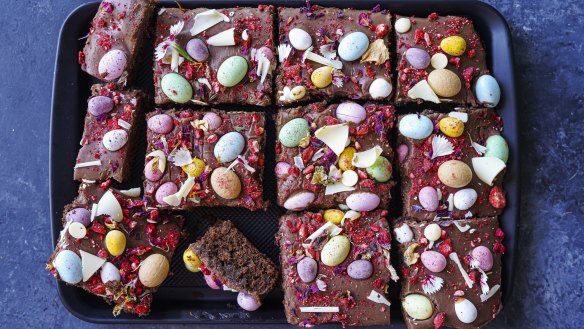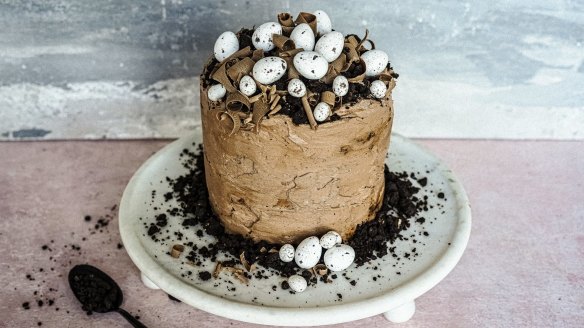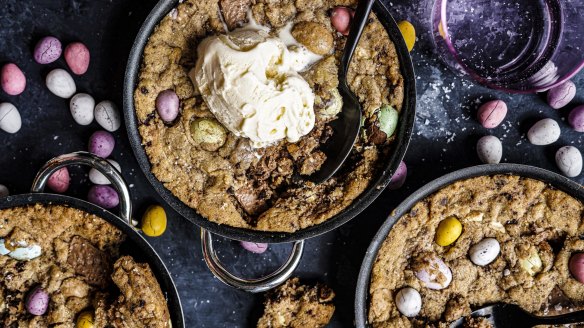Easy Easter chocolate bakes (and one eggstra marble layer cake)

Easter may be a time of hot cross buns and fish dinners and slow-cooked lamb lunches for some, but for me it is the childish obsession with Easter eggs that comes to the fore.
I love them. So much so it's problematic when they start turning up on supermarket shelves by February.
I can't hide my obsession with the coloured bits of foil, the crack of a candy-covered egg as it hits your teeth – it is my favourite way to eat chocolate.
These recipes are a celebration of glorious Easter eggs. Use them to stir through, to adorn or as the centrepiece. The possibilities are many, and I for one could not be happier.
Old-school slab cake with milk chocolate ganache and Easter eggs
A couple of tips: 1. Don't overwork the batter – the thinner level of cake means you have nowhere to hide, despite the simplicity.
2. Don't waste your money on coverture chocolate for the ganache unless you are very confident. The slightest overheating or touch of steam and your ganache will become grainy and useless. Decent quality cooking chocolate is far more forgiving and will still give excellent results.
INGREDIENTS
Cake
- 350g cake flour
- 355g caster sugar
- ½ tbsp baking powder
- ¼ tsp salt
- 225g unsalted butter
- 55g cocoa powder
- 1¼ cups tepid water
- 60ml espresso, cooled
- 115ml buttermilk
- 2 eggs, lightly beaten
- 1 tsp vanilla bean paste
Milk chocolate ganache
- 150ml thickened cream
- 400g milk chocolate, broken into pieces
To top
- assorted Easter eggs, chopped
- choc bits, to scatter
- freeze-dried raspberries
- edible flowers, to scatter
METHOD
- Grease and line a sheet pan or roulade tin (about 33cm x 22cm; something with higher sides to contain the batter) and preheat oven to 165C fan-forced (185C conventional).
- Whisk together the flour, sugar, baking powder and salt in a large bowl.
- To a saucepan, add the butter, cocoa powder, coffee and water, and place over low heat. Whisk until the butter has melted and the mixture appears smooth and glossy. Set aside to cool.
- Fold the cocoa mixture into the dry ingredients until just combined, being careful not to overwork the batter. Add the buttermilk, eggs and vanilla and whisk again until just combined.
- Pour the batter into the prepared tin and bake until cake has risen and appears to have come away from the edges slightly. Touch in the centre and the cake should spring back to the touch. This can take anywhere between 20 and 35 minutes, depending on your oven.
- Remove from the oven and allow to cool completely.
- To make the ganache, add the cream to a saucepan and place over low heat. Place the chocolate pieces in a bowl. Warm the cream, stirring often to prevent catching, until it is bubbling around the edges but is not boiling. Pour the cream over the chocolate and stir vigorously using a spoon. Set aside for 10 minutes to thicken.
- Spread the ganache across the cake and scatter with Easter eggs, chocolate chips, freeze-dried fruit and flowers.
Serves 16

Marble chocolate cake with chocolate buttercream, chocolate crumb and Easter eggs
This cake uses the reverse creaming method. Mixing the butter then eggs into the dry ingredients helps create a far more superior crumb and a light and lovely sponge. The results are far more consistent, and this is what we want and need when we go to the effort of making a cake.
INGREDIENTS
Marbling
- 85ml hot water
- 30g Dutch cocoa powder
Cake
- 450g low protein cake flour
- 450g caster sugar
- heaped tsp salt
- 2 tbsp baking powder
- 225g unsalted butter, softened and diced
- ½ tbsp vanilla bean paste
- 4 large eggs, at room temperature
- 400ml buttermilk, at room temperature
- 100ml vegetable oil (or any flavourless oil)
Chocolate buttercream
- 80g milk chocolate
- 20g Dutch cocoa powder
- 180g eggwhites
- 210g caster sugar
- 300g unsalted butter, softened to room temperature, chopped into tablespoon-sized chunks
- pinch salt
To decorate
- Chocolate cookie crumb (optional)
- realistic looking Easter eggs (I used Koko Black hazelnut praline eggs)
- ½ cup shaved chocolate
METHOD
- Preheat the oven to 165C fan-forced (185C conventional) and grease and line 3 x 23cm-round springform tins.
- For the marbling, heat the water in a saucepan until simmering. Pour into a bowl, add the cocoa powder and stir with a fork,. It will be a little lumpy but continue to mix until it becomes a thickish liquid. Set aside to cool while you prepare the batter.
- For the cake, add the flour, sugar, salt and baking powder to the bowl of a stand mixer, fitted with the paddle attachment. Pulse briefly to combine, then add the butter, in pieces, until incorporated – the mixture should resemble a sandy crumble. Beat for a minute or so here, this is building the structure so it's important not to rush this step.
- Add the vanilla then add the eggs, one at a time, and mix until incorporated before adding the next. Turn the mixer speed to low and slowly add the buttermilk, mixing until incorporated, then add the vegetable oil.
- Take a scant third of mixture and add to the bowl of marbling mixture and use a spoon to gently fold and combine.
- Layer the batter into your pans, starting with vanilla, then chocolate and ending with vanilla. You just want blobs of mixture, nothing overly precise. Use a knife to gently swirl the batter together in a few spots. Don't over-mix or the cake won't have a marbled interior.
- Bake the cakes for 35-40 minutes, or until a cake tester inserted into the centre comes out clean, or the centre of the cake springs back to your touch. Let the cakes cool for 10 minutes inside the tins before gently flipping them out. Wrap the cakes in clingfilm and place in the fridge to continue to cool. (As the cakes cool inside the clingfilm, they steam, and this adds further moisture to your sponge.)
- To make the buttercream, put the chocolate into a heatproof bowl set over a saucepan about a third-full of boiling water. Do not let the base of the bowl touch the water below. Stir, until the chocolate has melted, then remove and set aside to cool to a tepid temperature (keep the water in the saucepan). Stir through the cocoa powder, using a fork to remove any lumps.
- Put the eggwhites and sugar into the bowl of a stand mixer. Set it over the same saucepan filled with water. Heat, whisking constantly, until it reaches about 70C on a thermometer – the sugar will be dissolved and the mixture hot to the touch. Immediately remove then set the bowl onto a stand mixer fitted with the whisk attachment. Whisk on high speed until a thick and glossy meringue has formed and the bowl has cooled to room temperature (about 5-7 minutes). Add the butter, about a tablespoon's worth at a time, until fully incorporated. Lower the speed, gently add the melted chocolate mixture and beat until combined.
- To assemble, place a sponge on a plate. Smear over a quarter of the buttercream. Place the second sponge on top. Smear over another quarter of icing and top with final sponge. Add remaining buttercream all over the cake – we are not aiming for perfection here – and use a pallet knife to smooth the sides and create some lovely ripples on top.
- Sprinkle over the chocolate cookie crumb, if using, then top with shaved chocolate. Lastly top with the Easter eggs.
Note: This cake is best served at room temperature. Given the butter content of the buttercream, cold from the fridge is not ideal.
Serves 10 generously
Biscoff ganache eggs with dulce de leche
There was a wild and furious internet moment of eggs filled with cheesecake and then Biscoff. Loved the concept, not so much the cheesecake filling, so I have swapped it out for a Biscoff ganache. Given the richness, I have suggested each half eggshell to serve 2. You could also fill smaller hunting-sized Easter eggs for individual serves.
INGREDIENTS
- 1 medium-sized Easter egg, gently halved
Biscoff ganache
- ½ cup white chocolate
- ½ cup thickened cream
- ½ cup Biscoff spread
- ½ cup dulce de leche
- 2 Biscoff biscuits, crushed to a crumb
- 2 Biscoff biscuits to serve
METHOD
- Chop the white chocolate into small pieces and place into a bowl.
- To a small saucepan, add the cream and place over medium heat. Heat the cream but do not let it boil, if you do it will split the chocolate. It should only just be beginning to bubble around the edges of the saucepan. Immediately remove and pour over the chocolate. Let sit for 5 minutes, uncovered.
- Vigorously stir with a spoon – it may seem like it's not coming together, but it will. Once smooth and glossy, add the Biscoff spread, a few spoonfuls at a time, and mix until incorporated.
- Scoop the ganache into the Easter egg halves then place in the fridge for 20 minutes to firm up.
- When ready to serve, bring the eggs to room temperature. Add a scoop of dulce de leche to each egg, sprinkle over some crushed Biscoff, top with a Biscoff biscuit and serve.
Serves 4

Easter egg frypan cookies
You can make this in one larger nonstick ovenproof frying pan instead of 3 individual pans, just note you will need to bake it for slightly longer if using one larger pan, add 5-minute increments to your cooking time and check as you go.
INGREDIENTS
- 2 cups plain flour
- 1 tsp bicarbonate of soda
- sea salt flakes
- 225g unsalted butter, softened
- 1 cup brown sugar, firmly packed
- ½ cup caster sugar
- 2 tsp vanilla bean paste
- 3 egg yolks
- 1 cup mixed mini Easter eggs, some chopped, some whole
- ½ cup chocolate chunks (I used a mix of dark, milk and white)
- sea salt flakes
- ice-cream (optional), to serve
METHOD
- Preheat oven to 170C fan-forced (190C conventional). Grease 3 to 4 18cm nonstick ovenproof frypans (or 1 large pan).
- Mix together the flour, bicarb soda and a pinch of salt in a bowl.
- Beat the butter, sugars, vanilla and another pinch of salt until pale and creamy, about 3-5 minutes. Add the egg yolks and beat until well combined.
- Use a spatula or wooden spoon to stir through the flour until combined. Mix in the Easter eggs and chocolate chunks. Divide the cookie dough into the prepared pans and use your fingers to push the dough to the edges.
- Bake for 15-18 minutes or until lightly golden on top. It's important not to overbake a frypan cookie, these are best eaten when the centre is slightly underdone. Remove from the oven, add another pinch of sea salt flakes and allow to cool for 3 minutes before eating warm. Top with a scoop of ice-cream as an added extra.
Serves 6-8
